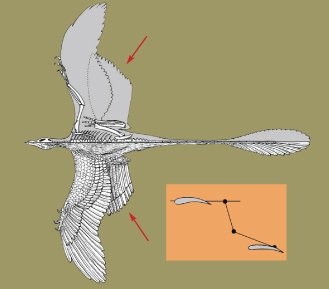An Ancient Feathered Biplane
- 指点迷津
- 2024-11-30
- 5
New evidence suggests that dinosaurs4 may have beaten the Wright Brothers to the punch in coming up with a biplane design.
| A fossil of a gliding dinosaur known as Microraptor gui. The inset is an enlarged view of the animal's leg feathers. |
| PNAS |
Four years ago, paleontologists described a species of dinosaur from China called Microraptor gui. These dinos were about 3 feet long and feathered. They even had feathers on their legs and feet.
The leg feathers puzzled scientists. Some researchers proposed that the dinosaurs opened their legs into a split when they flew, creating a second set of wings behind the first. None of M. gui's closest relatives, however, had hips6 that were flexible enough to stretch out that far.
Now, two scientists have a new theory of how these creatures glided7. Their model proposes that M. gui dangled8 its legs underneath9 its body while in the air. This would have created two sets of wings, one below and slightly behind the other. Biplanes that do aerobatic stunts10 have a similar design.
 |
| This drawing shows what the dinosaur might have looked like. The second set of wings (arrows in main image) created when this dinosaur dangled its feathered legs and feet below its body would have provided flight surfaces like those of a modern biplane. The inset shows the positions of the dinosaur's two sets of wings, as seen from the side. |
| PNAS |
The 19-centimeter-long feathers near the bottom of the animal's legs support this theory, the scientists say. Their design would have helped keep the feathers from twisting as the dinosaur generated lift.
Based on this model, the scientists say that M. gui probably could not have survived a vertical11 fall from a tall tree. However, computer flight simulations show that, if the animal took a strong horizontal leap from a branch, its biplane wings could have carried it to other trees at least 40 meters (130 feet) away. The technique would have made M. gui efficient in the air, but the dinosaurs were probably not very graceful12 on land. They did not have strong chest muscles, suggesting that they could not take off from the ground. And with such long leg feathers, the animals probably would have tripped all over themselves while walking.—E. Sohn
Secrets of an Ancient Computer
奥巴马演讲 An Obligation to Those Who Serve the Country
An Old-Fashioned Girl - Preface
An Old-Fashioned Girl - Chapter 3
An Old-Fashioned Girl - Chapter 4
An Old-Fashioned Girl - Chapter 6
An Old-Fashioned Girl - Chapter 8
An Old-Fashioned Girl - Chapter 10
本文由明日于2024-11-30发表在生活百科-红苹果乐园,如有疑问,请联系我们。
文章摘自:http://hpgly.com/post/33460.html



![[流言板]雷尔森传中,穆科科近距离射门打飞](/zb_users/upload/2024/12/3111596453046865195.gif)
发表评论